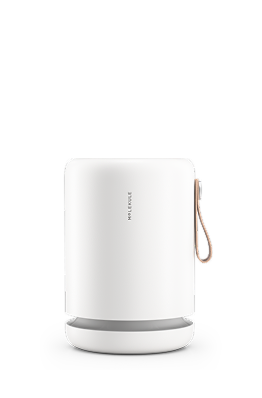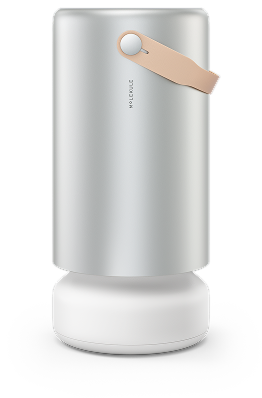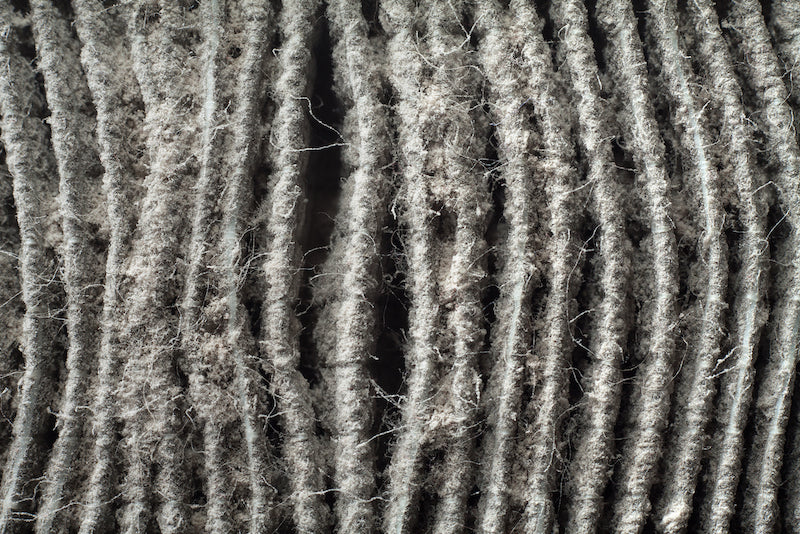Your home is a space that should allow you to control the influence of outdoor temperatures, precipitation, and pollution. However, sealing your home from the outdoors can also trap pollutants indoors, in some cases allowing air pollution to build up to unhealthy levels. A wide range of substances can affect the air quality in your home, including particulate matter, toxic gases, viruses and bacteria. Air purifiers can help remove some of these substances from indoor air, but their ability to do so depends on their filtration technology. Read on to see how the different types of air filters on the market stack up against different sources of air pollution.
Mechanical filtration for particulate matter
Particulate matter (PM) is a term used to describe the mixture of solid particles and liquid droplets that can pollute the air. Some of these particles can be seen by the naked eye, such as the dust you see floating in the air when sunlight streams into a room. However, other types of PM are so small that they can only be seen under a microscope. Particle pollution can include smoke particles, dust, pollen and pet dander.
Particle pollutants are classified according to their approximate size in microns (a micron is one ten-thousandth of a centimeter). Particles that are 10 microns or less are called PM10. Though they are easy to inhale, their size generally prevents them from moving beyond the upper respiratory tract. PM2.5 and PM1.0 are considered a more significant potential health hazard because they are small enough to move through the lungs into the bloodstream and internal organs.
Which air filters can handle particulate matter?
When you are looking for an air purifier, you want one that can handle particles down to 0.1 microns in size (PM0.1). Ideally, an air purifier’s mechanical filtration system should have been tested by an independent laboratory and found to efficiently remove PM0.1 from the air with negligible bypass of particulate matter around the filter in the device.
Mechanical filters are made of a finely-woven mesh that catches particles as air passes through. HEPA filters are a type of mechanical filter certified to trap at least 99.7 percent of all PM 0.3 microns in size. Like most types of filters, HEPA filters become less effective as they capture more particle pollution, so they need to be replaced regularly.
When shopping for a HEPA air purifier, it is important to note whether the manufacturer advertises a true HEPA filter or a HEPA-type filter. Unfortunately, a lack of regulation means that the latter is not guaranteed to meet any standard of air purification, so it is virtually impossible to know how well a unit with a HEPA-type filter will remove PM from the air. Quite simply, a HEPA-type filter may be nearly as effective as a true HEPA filter, or it may not be effective at all.
Ionizer air purifiers remove PM from the air without the use of a mechanical filter. Instead, they add a positive or negative charge to oxygen molecules in the air, forming ions that react with airborne particles. This causes the particles to become heavy enough to settle on the surfaces of your home. While ionizers can technically reduce airborne PM, the heavier particles they create can be easily kicked back into the air by human activity and airflow. Some ionizers include a charged filter so that it acts as a collector plate. Additionally, ionizers can create ozone as a byproduct, a pollutant linked to harmful health effects in humans.
Photo Electrochemical Oxidation (PECO) filters are also made up of a mesh that catches PM as air passes through and require regular replacement. However, fibers in the PECO filter are coated with a special catalyst. This catalyst reacts with light to break down organic pollutants, such as allergens. Non-organic particles remain trapped in the filter, but organic particles are destroyed completely.
Chemical filtration for gaseous pollutants
Some pollutants are too small to be captured by mechanical filters, including the molecules that make up inorganic gases and volatile organic compounds (VOCs). Inorganic gases include substances such as radon, ozone (O3), carbon monoxide (CO), nitrogen dioxide (NO2) and sulfur dioxide (SO2). These gases can come from a variety of sources, both industrial and natural. They are toxic to inhale, and exposure is associated with a wide range of health problems.
VOCs are a different class of substances that can be just as toxic as inorganic gases. They typically start out as solids or liquids, but evaporate easily at room temperature. These gases can be created naturally, but they are often found in manufactured products, building materials, cleaning chemicals and solvents. VOCs commonly found in the home include benzene, formaldehyde and methylene chloride.
Not all VOCs are inherently hazardous to human health. However, some, including the ones mentioned above, are known or suspected carcinogens. Short-term exposure to VOCs can cause allergy-like symptoms in sensitive individuals. Chronic exposure to high levels of VOCs has been linked to more severe health effects, such as damage to the kidney, liver and central nervous system.
Which air filters are effective against gaseous pollutants?
Because the molecules in gaseous pollutants are too small to be captured by mechanical filters, you need something beyond HEPA to remove VOCs and harmful gases from the air. Currently, there are two main air purification technologies that are effective against airborne chemicals: activated carbon filters and PECO.
Activated carbon filters house a bed of activated charcoal or another form of carbon laid out in a lattice structure to provide the greatest possible surface area. As air passes over or through the carbon, chemical gases get stuck on the filter due to a process called adsorption. The more pollutants get stuck to the surface of the filter, the less available adsorption space remains. This can cause the filter to become less efficient over time. Changes in temperature and humidity can also affect how well VOCs and gases adhere to the filter.
Because carbon filters have so many open spaces for gases to stick to, PM can flow through them without being captured. To be effective against particle pollution, air purifiers with activated carbon filters need to be paired with a mechanical filter, such as HEPA.
While PECO technology is not effective against inorganic gases, PECO technology goes beyond simply trapping the harmful organic gases found in indoor air. It uses a chemical reaction to attack and destroy gaseous pollutants that pass through the filter, converting them into harmless water and carbon dioxide molecules. Like most air purification technology, PECO filters also must be replaced over time. In independent testing from the nationally recognized lab, Intertek, Molekule Air, Air Mini, and Air Pro (all of which utilize PECO technology) were all found to effectively destroy VOCs and convert them into nontoxic substances.
Biological filtration for bioaerosols
Bioaerosols are pollutants that come from living things. They include both living and nonliving materials, such as fungi, mold spores, pollen, viruses and bacteria. This group of pollutants technically contains some particulate matter, such as pollen and mold spores, as well as viruses and bacteria.
Viruses and bacteria are common components of air, and they are not always a cause for concern. Many airborne viruses, including the flu and the common cold, are suspended in liquid droplets released when an infected individual talks, coughs or sneezes. These droplets are only present in the air for a short while before they settle on the ground or another surface. However, some viruses may be transmitted more easily through the air.
Like viruses, infection-causing bacteria can also be spread through the air. Though much of the bacteria present in the environment are harmless or even beneficial, some strains can cause serious infection, such as strep, staph and tuberculosis.
Which air filters work against bioaerosols?
Removing bioaerosols from the air merits special consideration because of their potential to gather and grow on surfaces. Simply trapping bioaerosols such as mold spores and bacteria in a filter is not enough to get rid of them. Instead, an air purifier should go a step further and destroy them completely.
HEPA and carbon filters can be effective against PM and VOCs, respectively, and can trap bioaerosols. However, they lack the technology to destroy bioaerosols. Moreover, they may actually give bacteria a place to grow and be released into your indoor air. For example, HEPA filters capture dust, which can be a host for fungi and bacteria. The activated carbon present in carbon filters can also play a similar role in the growth of bacteria inside an air purifier. Once bioaerosols start growing on these types of filters, they can become dislodged and re-enter the air.
UV-C air purifiers, on the other hand, can inactivate bioaerosols, including mold spores, bacteria and viruses. They utilize short-wave ultraviolet light that makes these pathogens unable to grow or create new toxins, though it does not technically destroy them. Ultraviolet light technology is commonly used in hospitals to decrease the spread of airborne disease. However, UV-C air purifiers created for home use may not be as effective as those found in hospitals. Plus, some models can produce harmful ozone as a byproduct of their operation.
PECO technology takes a different approach. Molekule air purifiers use a light-activated chemical reaction to destroy airborne bioaerosols at the molecular level. When scientists from the University of Minnesota tested the Air Mini’s effectiveness against strains of airborne animal coronavirus and influenza, they found that it inactivated 99.9% of airborne viruses within a single pass through the filter.* In fact, they observed that the PECO technology started inactivating the viruses immediately after they came into contact with the filter.
Many kinds of pollution can affect the air quality in your home. Unfortunately, not all air purifiers are effective against all the different substances found in indoor air. Now that you know how effective different air filters are when faced with different types of pollutants, you can make a more informed decision on which type of air purifier you want for your home.
*Molekule devices have not been tested on COVID-19. While air purifiers can provide an additional layer of protection to help reduce viral exposure, Molekule encourages use of PPE and medical countermeasures suggested by government authorities.







